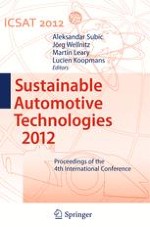
2012 | OriginalPaper | Buchkapitel
Reduction of Nickel-Alloyed Stainless Steels in Automobile Systems by Laser Beam Welding of Austenitic-Ferritic Connections While Maintaining an Adequate Corrosion Resistance
verfasst von : M. Weigl, M. Schmidt
Erschienen in: Sustainable Automotive Technologies 2012
Verlag: Springer Berlin Heidelberg
Aktivieren Sie unsere intelligente Suche, um passende Fachinhalte oder Patente zu finden.
Wählen Sie Textabschnitte aus um mit Künstlicher Intelligenz passenden Patente zu finden. powered by
Markieren Sie Textabschnitte, um KI-gestützt weitere passende Inhalte zu finden. powered by
Nowadays mostly austenitic stainless steels, which are alloyed with the element nickel, are used for applications with demanding requirements concerning the chemical properties and corrosion resistance. Therefore in current automobile systems in the mid-range and premium price segment the exhaust piping is normally made of nickel-alloyed stainless steels, see figure 1. With regard to modern mobile systems, such as automobiles powered by hydrogen fuel cells and alternative liquid propellants nearly all components for the storage, transportation and chemical reactions are made of nickel-alloyed stainless steels. These types of steels typically feature an excellent chemical and thermal performance, which is often not necessary for the whole system. Thus quite a huge amount of nickel is wasted at installation positions and area of operation not requiring that high chemical persistency. For such installations with lower demands on the corrosion resistance also nickel-free ferritic stainless steels could be used. In order enable a reduction of the nickel-alloyed materials by ferritic variants without a decrease of chemical performance in the connection an appropriate joining strategy has to be engineered. In this context the present article presents the latest results of a research project dealing with austenitic-ferritic stainless steel connections performed by laser beam welding. By a reduction of nickel both economic as well as environmental improvements can be reached: On the one hand the high and also fluctuating market price of nickel leads to notably rising prices of nickel-alloyed steels, for which reason nickel-free variants offer cost savings up to 40%. On the other hand there is reasonable suspicion that the element nickel is carcinogen caused serious damage to the health of human beings, hence nickel should also be avoided as far as possible for this reason.